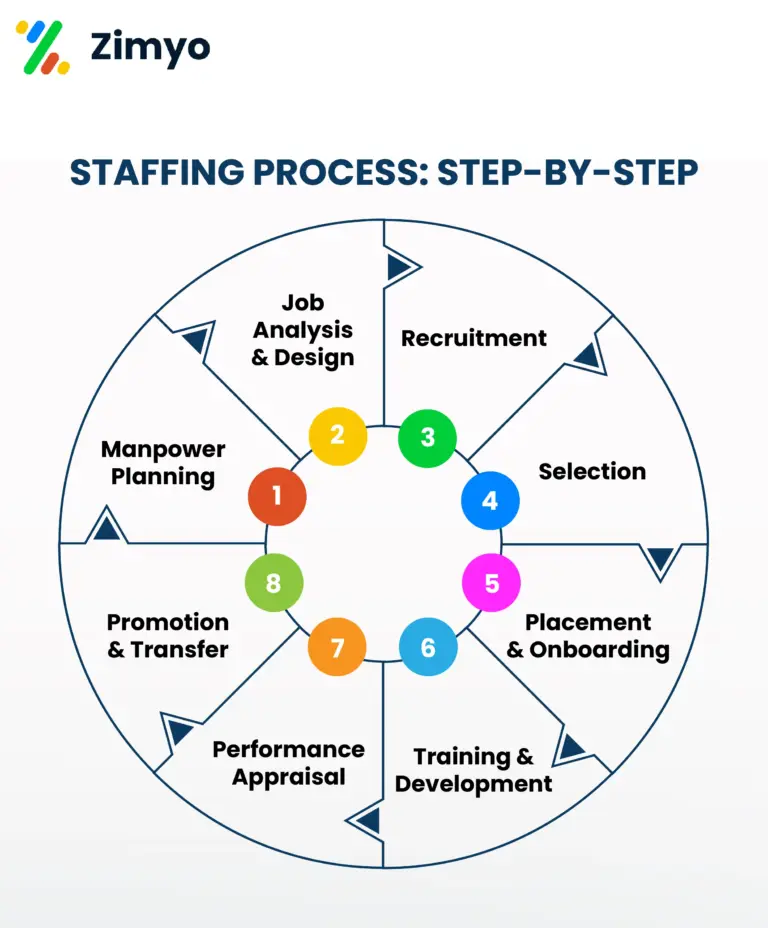Staffing meaning refers to the process of finding, selecting, training, and placing the right people in the right jobs within an organization. It is a key function of human resource management and plays a vital role in building an effective and productive workforce.
Whether you are managing a startup or running a large organization, staffing ensures that every role is filled by someone with the necessary skills and capabilities. In simple terms, it’s about having the right people, at the right time, doing the right job.

What is Staffing?
If you’re wondering, what is staffing, the answer is straightforward. Staffing is the ongoing process of hiring and developing employees so that an organization can achieve its goals effectively. It involves more than just recruitment—it includes workforce planning, training, development, performance appraisal, and retention.
When we define staffing, it is often described as a cycle that starts with identifying the need for human capital and ends with monitoring and retaining those resources.
Define Staffing in Management
To define staffing in management, it’s important to look at it as one of the key managerial functions, along with planning, organizing, directing, and controlling. Managers are responsible for ensuring that positions are filled with competent employees who can help achieve the company’s strategic objectives.
Staffing in management helps in:
- Avoiding talent shortages
- Reducing hiring mistakes
- Improving team productivity
- Supporting business growth

Staffing Process: Step-by-Step
Understanding the staffing process helps organizations organizing their hiring and employee development practices. Here’s a simple breakdown of the process:
1. Manpower Planning
Determine the number and types of employees needed.
2. Job Analysis and Design
Define roles, responsibilities, and qualifications.
3. Recruitment
Attract potential candidates through job postings, agencies, or referrals.
4. Selection
Screen and choose the most suitable candidates through tests and interviews.
5. Placement and Onboarding
Assign new hires to appropriate positions and introduce them to the organization.
6. Training and Development
Equip employees with the skills and knowledge they need to perform effectively.
7. Performance Appraisal
Evaluate employee performance and provide feedback.
8. Promotion and Transfer
Recognize talent and offer internal growth opportunities.
Types
There are various types of staffing based on organizational needs:
1. Permanent Staffing
Hiring employees for long-term roles with full-time responsibilities.
2. Temporary Staffing
Employing workers for short-term projects or seasonal work.
3. Contract Staffing
Hiring professionals for a specific period or task, often via third-party agencies.
4. Internship Staffing
Engaging students or freshers for learning and hands-on experience.
5. Remote Staffing
Hiring talent that works virtually from different locations.
Importance of Staffing
The importance of staffing in an organization cannot be overstated. Here’s why it is essential:
- Ensures the right fit between jobs and employees
- Promotes employee satisfaction and retention
- Boosts organizational efficiency and productivity
- Supports succession planning
- Encourages innovation through diverse talent
Effective staffing creates a strong foundation for any business to thrive and adapt to market changes.
Select Staffing Solutions Wisely
Select staffing approach right depending on your company’s size, structure, and hiring needs. Many businesses partner with staffing agencies to manage recruitment and workforce planning efficiently. These solutions save time, reduce hiring risks, and provide access to a larger talent pool.
Conclusion
To wrap it up, understanding staffing meaning helps businesses build strong teams and grow sustainably. Whether you are a small business owner or an HR manager, mastering the staffing process is crucial for long-term success.
By knowing staffing completely you can make better hiring decisions and create a productive work environment.
FAQs:
Staffing in HR refers to the process of recruiting, selecting, training, and developing employees to fill organizational roles effectively.
Staffing ensures the right people are hired for the right roles, which improves productivity, reduces turnover, and supports business growth.
The main types of staffing include permanent, temporary, contract-based, internship, and remote staffing.
Recruitment is a part of the staffing process focused on attracting candidates, while staffing includes recruitment, selection, onboarding, and employee development.
